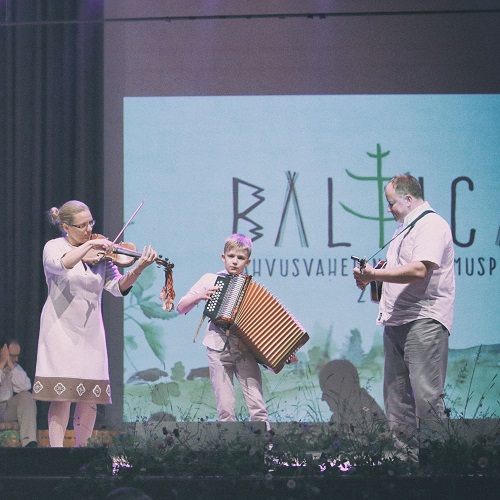Krista and Raivo Sildoja are the perfect example of village musicians. They are exceedingly knowledgeable about music and have studied their own culture as well as foreign, having travelled an seen quite a bit of the world. They share their knowledge through teaching and raise their children in the spirit of folk culture.
As violinists, Krista and Raivo were present at the very first Sabatants festival in 2012. Although we haven’t seen them among performers since, they have kept an eye on the festivals’ endeavours. As Krista admits, Tallinn is not all too near to Mooste and their main focus remains on projects closer to home in South Estonia – running their own folk music school, camps, presentations and so on. Raivo’s time goes often into making kannels and talharpas in his workshop. While in the past they also had several ensemble projects, now their time is mostly devoted to writing down old folk tunes and gathering them into anthologies. Only recently, a new e-textbook for aspiring adult folk musicians saw the light of day.
Mooste Folk Music School – family project of the Sildojas – is special for their venture to spread the knowledge on how to be a village musician. They believe that in addition to masterful handling of the instrument, being a one needs to be able to rise to the occasion in every situation – to know how to act and play, be it at a village party or a grand stage, a park, a funeral or a dance evening. How to be open, human and empathetic; to give and receive what the moment in question demands on offers. In truth, there can not be one definitive answer to these questions. However, we can pursue the truth in these matters by delving into our culture, honoring the input and individuality of our predecessors and striving to be worthy of it. In Krista’s imagination, every musician would have their own style of playing – so that when listening to them with one’s eyes closed, it would still be easy the recognise the player.. In the same time, every region in estonia would also have their individual collective sound, that would in turn contribute to the sound of whole Estonia’s folk music. Raivo’s instruments offer an analogy to this image as they are authentic while singular and exceptional, upgraded according to contemporary times.
According o Krista, playing for dancers is a special skill different from playing to listeners. Being a dancer themselves can benefit the musician in that department. Krista and Raivo are not usually the first or last on the dancefloor, but even so they search to build a contact with the dancers. As they play on the stage, they let the dance pass through their bodies, feeling and searching, so that their music would carry the dancers around them. Playing for dancing is not a skill that neither of them learned from someone, however one of their personal heroes – Ain Sarv – has said that it feels good to dance to their playing. They are encouraged by this positive feedback to keep learning, self-analysing and playing.
Raivo and Krista consider themselves lucky to have been born into a family of musicians, but they don’t see it as a premise nor as an advantage. They hold their teachers and idols in high regard – such as Ain and Õie Sarv, Arne Haasma, Indrek Kalda, Igor Tõnurist, the group Leegajus, Vaike Sarv, Ingrid Rüütel, all their tutors in Estonian Academy of Music and Theatre and Viljandi Culture Academy, all their pupils that have come and gone. Vaike Sarv has left them with a philosophy of always knowing after whom a certain tune is learned and played. This is a display of respect towards preceding players, one that they always try to follow and expect from others alike.
After a long pause, Krista and Raivo are back at Sabatants with their violins and talharpa’s – along with their young son Mihkel, who plays both a german type and teppo-type estonian accordeon.
www.rahvamuusika.ee
www.kannel.ee
eestiviiul.rahvamuusika.ee
folkmusicbaltics.weebly.com


